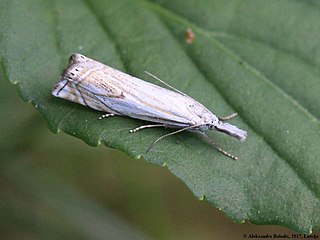
Colotis etrida, the little orange tip, is a species of butterfly in the family Pieridae. It is native to India, Sri Lanka and Pakistan.

Dysgonia algira, the passenger, is a moth of the family Noctuidae. The species was first described by Carl Linnaeus in 1767 and is found in the Palearctic - from the southern half of Europe and parts of North Africa through West, Central and South Asia.

The gorse tip moth is a smallish moth species of the family Depressariidae.

Lygephila craccae, the scarce blackneck, is a moth of the family Erebidae. It is found in temperate Europe and across the Palearctic to the Altai Mountains, Korea, Japan and China.

Depressaria daucella is a moth of the family Depressariidae. It is found in most of Europe, except most of the Balkan Peninsula. It is also found in North America.

Crambus uliginosellus is a species of moth in the family Crambidae. It was first described by Zeller in 1850 and is currently found in most of Europe, except Portugal, Slovenia, Croatia and Ukraine.
Boeotarcha divisa is a moth in the family Crambidae. It was described by Thomas Pennington Lucas in 1894. It is found in Australia, where it has been recorded from Western Australia.
Tabidia strigiferalis is a moth in the family Crambidae. It is found in China, Korea and Russia.
Metallarcha erromena is a moth in the family Crambidae. It was described by Turner in 1908. It is found in Australia, where it has been recorded from Queensland.
Microphysetica ambialis is a moth in the family Crambidae. It was described by William Schaus in 1924. It is found in Mexico (Xalapa) and Guatemala.
Pilocrocis dichocrosialis is a moth in the family Crambidae. It was described by George Hampson in 1912. It is found in Cameroon, the Democratic Republic of the Congo (Katanga), Malawi, Mozambique, Zambia and Zimbabwe.
Prenesta rubralis is a moth in the family Crambidae described by George Hampson in 1898. It is found in Peru and Ecuador.
Syllepte agraphalis is a moth in the family Crambidae. It was described by George Hampson in 1912. It is found in Bhutan and Assam, India.
Udea diopsalis is a moth in the family Crambidae. It was described by George Hampson in 1913. It is found in Chile.
Mnesictena pantheropa is a moth in the family Crambidae. It was described by Edward Meyrick in 1884. It is endemic to New Zealand, where it has been recorded from the Chatham Islands.
Udea scoparialis is a moth in the family Crambidae. It was described by George Hampson in 1899. It is found in Tibet, China.
Ulopeza sterictodes is a moth in the family Crambidae. It was described by George Hampson in 1912. It is found in Papua New Guinea.
Ambia mesoscotalis is a moth in the family Crambidae. It is found in Indonesia, where it has been recorded from the Maluku Islands (Banda).
Ambia oligalis is a moth in the family Crambidae. It is found on the Louisiade Islands.

Catopyrops ancyra, or Felder's lineblue, is a species of butterfly belonging to the lycaenid family described by Cajetan Felder in 1860. It is found in the Indomalayan and Australasian realms.






